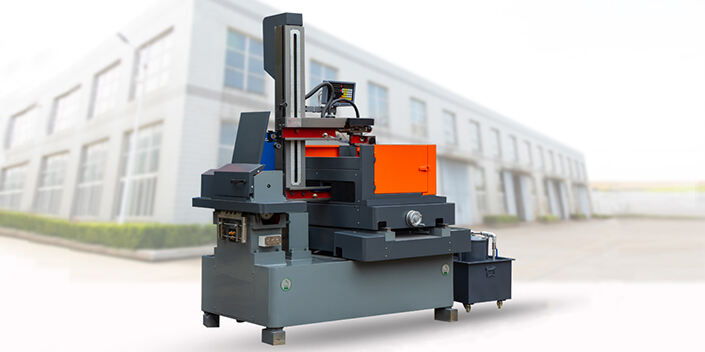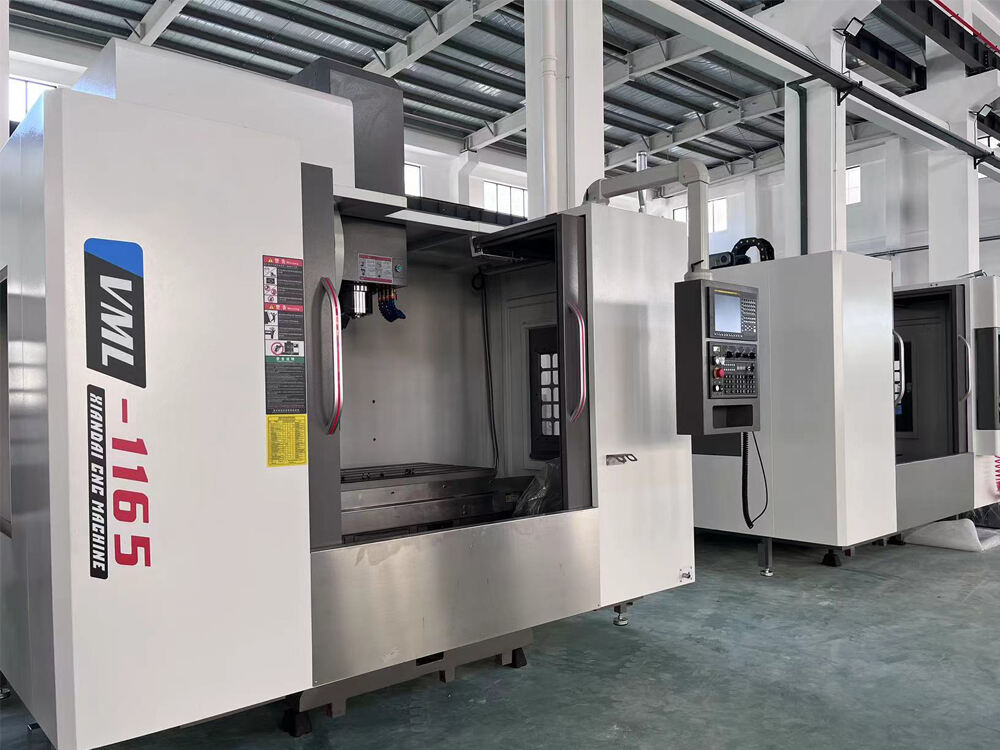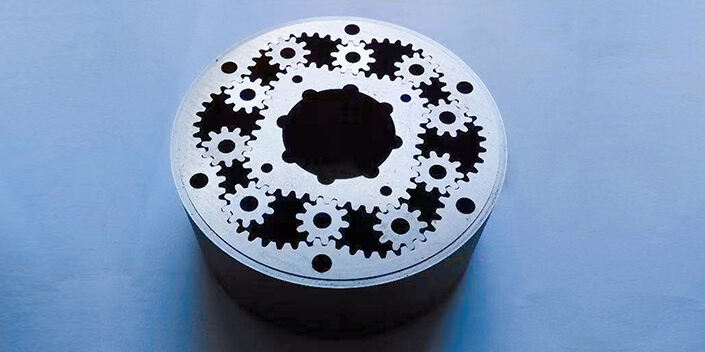금속 회전 및 성형을 위한 터닝 머신 도구 이해하기
터닝 머신은 주로 금속 가공에서 재료를 성형하고 기계가공하는 다목적 도구입니다. 이 기계는 작업물을 고정된 절삭 도구 주위에서 회전시켜 대칭적이거나 원통형, 원추형 모양의 부품을 형성하기 위해 정확한 재료 제거를 가능하게 합니다. 이 기계는 자동차 및 항공 우주 산업과 같은 상세한 금속 부품이 필요한 산업에서 필수적입니다.
터닝 머신의 기본 작동 원리는 작업물이 회전하면서 절삭 도구는 고정되어 있는 것입니다. 이러한 구조는 일관되고 정밀하며 효율적인 재료 제거를 가능하게 합니다. 작업물이 회전할 때 절삭 도구는 특정 동작 명령에 따라 표면을 원하는 형태와 크기로 전략적으로 줄입니다.
터닝 머신의 주요 구성 요소에는 베드, 캐리지, 테일스톡, 그리고 스피нд가 포함됩니다. 베드는 기반 역할을 하며 다른 부품들을 지지하고 정렬합니다. 캐리지는 베드 위를 이동하며 절삭, 성형 또는 드릴링에 사용되는 도구를 운반합니다. 테일스톡은 도구를 고정하거나 긴 작업물을 지지하며, 스피нд는 재료를 회전시킵니다. 이러한 구성 요소들은 함께 작동하여 효과적인 가공을 가능하게 하고, 스레딩에서 보링에 이르는 다양한 작업을 수행할 수 있도록 합니다.
금속 가공용 레이스 머신 도구의 유형
旋盤 기계는 금속 가공에서 빠질 수 없는 도구이며, 그 다양한 종류를 이해하면 적용 범위를 결정하는 데 도움이 된다. 엔진 라테는 가장 다재다능하고 널리 사용되는 유형 중 하나로, 단순한 회전 작업부터 더 복잡한 절삭 작업까지 다양한 작업을 처리할 수 있는 것으로 잘 알려져 있다. 자동차 및 항공 우주와 같은 다양한 산업에서 엔진 라테는错 복잡한 부품을 제작하고 상세한 금속 부품을 조립하는 작업에 활용된다. 이 기계들은 견고한 구조와 설계 덕분에 정확한 작동이 필요한 무거운 작업과 다양한 작업 환경에서 뛰어난 성능을 발휘한다.
또한, 타렛 터닝 센터는 반복적인 생산 작업에서의 효율성으로 인해 돋보입니다. 이러한 기계들은 빠른 도구 교체를 위해 설계되어 고속 생산이 요구되는 제조 환경에서 이상적인 선택입니다. 전자 산업과 소비재 제조와 같은 대량 생산에 중점을 두는 산업들은 수동 도구 교환과 관련된 다운타임을 줄여 사이클 시간을 단축하고 출력을 증가시키기 위해 타렛 터닝 센터를 활용합니다.
CNC 터닝 센터는 터닝 기술의 최고봉으로, 컴퓨터 제어를 통해 뛰어난 정밀도와 복잡한 형태의 가공 능력을 제공합니다. 의료기기 제조 및 고급 엔지니어링 회사와 같은 세부 사항과 완벽한 정확성이 필요한 산업에서는 종종 CNC 터닝 센터에 의존합니다. 이러한 기계는 매우 상세하고 맞춤형 부품을 생산하기 위해 복잡한 명령을 실행할 수 있으며, 모든 제품이 엄격한 사양을 충족하도록 보장합니다. 컴퓨터 지원 제어를 사용함으로써 CNC 터닝 센터는 효율성과 정확성을 향상시키고, 인적 오류를 줄이며 생산 신뢰성을 증가시킵니다.
엔진 터닝 센터에서 CNC 터닝 센터에 이르는 다양한 터닝 머신 도구들은 산업에 특정 생산 요구에 맞춘 맞춤형 솔루션을 제공하여 효율성과 출력 품질을 모두 개선합니다.
금속 성형에서 터닝 머신 사용의 이점
터닝 센터는 정밀 공학에서 중요한 역할을 하며, 고품질의 금속 가공에 있어 필수적인 내경 및 마감면 품질의 상당한 개선을 제공합니다. 산업 데이터에 따르면, 터닝 센터의 정확성은 마이크론 단위의 정밀도를 가능하게 하여 부품의 치수 정확성과 표면 마무리를 모두 향상시킵니다. 이러한 정밀성은 가장 작은 편차조차 전체 성능과 제품 수명주기에 영향을 미칠 수 있는 산업에서 필수적이 되었습니다.
터닝 센터는 그들의 다용도로 인해 칭송받고 있으며, 다양한 산업에 걸쳐 적용되는 그들의 기능은 이 특징을 강조합니다. 맞춤 부품 제조에서 프로토타입까지, 복잡한 항공 우주 부품을 제작하거나 맞춤형 자동차 부품을 생산하는 데 있어 터닝 센터의 다양한 재료와 형태를 처리할 수 있는 능력은 여러 부문에서의 광범위한 사용을 보장합니다. 이러한 유연성은 제조업체들이 복잡한 설계 사양을 충족하고 독창적인 구성 요소를 효율적으로 생산할 수 있도록 합니다.
터닝 머신을 사용함으로써 얻을 수 있는 생산 효율성의 향상은 더 빠른 생산 속도와 낭비 감소를 보여주는 통계적 데이터에 의해 강조된다. 터닝 머신의 효율적인 운영은 제조 과정을 가속화할 뿐만 아니라 재료 낭비를 최소화하여 비용 절감과 더 지속 가능한 생산 환경을 가져올 수 있다. 이와 같은 속도와 재료 효율성의 조합은 전체 처리량과 생산성을 향상시키며, 터닝 머신을 대량 생산 라인에서 선호하는 선택지로 만들고 있다.
판매 중인 금속 터닝 머신을 고를 때 찾아볼 핵심 기능
금속 터닝 센터를 구입할 때 모터 파워와 속도 설정은 중요한 고려 사항입니다. 이러한 요소들은 기계가 다양한 재료와 절삭 작업을 처리하는 능력에 직접적인 영향을 미칩니다. 강력한 모터는 효율적인 성능과 다양한 작업을 처리할 수 있는 능력을 보장하며, 조절 가능한 속도 설정은 특정 프로젝트 요구에 맞게 작업의 유연성을 제공합니다. 이러한 기능들을 평가할 때, 작업할 재료의 종류와 계획 중인 작업의 다양성을 고려해야 합니다.
내구성과 구조 품질은 레이저 머신의 수명에 크게 영향을 미치는 기본적인 속성입니다. 재료 선택과 제작 방법은 기계의摩耗 및 파손에 대한 저항에 직접적으로 영향을 미칩니다. 주조 철과 같은 고급 소재로 만들어진 레이트는 진동을 더 잘 흡수하고 더욱 우수한 안정성을 제공합니다. 이러한 견고함은 기계가 성능을 저하시키지 않고 집약적이고 장기간의 사용에 견딜 수 있도록 보장하며, 유지보수의 빈도를 줄이고 조기 교체의 필요성을 감소시킵니다.
통제 메커니즘 발전하고 있어, 전통적인 수동 제어와 현대 디지털 인터페이스를 비교하는 것이 중요합니다. 전통적인 수동 제어는 일부 기계 조작자들이 정밀 작업에 선호할 수 있는 촉각 피드백 루프를 제공합니다. 그러나 디지털 인터페이스는 프로그래밍 가능한 작업을 통해 향상된 정밀도를 제공하며 사용자 친화적인 설정을 제공합니다. 이러한 현대 시스템은 자동 안전 기능을 포함하고 더 복잡한 가공 작업을 가능하게 하여 사용자 경험과 운영 효율성을 최적화합니다.
旋盤기계가 현대 제조 과정에서 차지하는 역할
레이저 기계는 CNC(컴퓨터 수치 제어) 기술을 통합하여 현대 제조 과정에서 중요한 역할을 하며, 이는 금속 가공의 정밀도와 자동화를大幅히 향상시킵니다. 이 기술은 이전에 수작업으로 수행하기 어려웠던 상세하고 복잡한 작업을 가능하게 합니다. CNC 기술을 사용하면 제조업체는 최소한의 인적 개입으로 복잡한 설계와 사양의 부품을 생산할 수 있습니다. 그 결과, 회사들은 일관된 품질을 보장하고 오류율을 줄여 생산성과 효율성을 높일 수 있습니다.
터닝 센터의 다용성은 항공우주 및 자동차 산업에서 특히 두드러지게 나타납니다. 이곳에서는 특정 부품들이 높은 정밀도를 요구합니다. 예를 들어, 항공우주 분야에서는 터닝 센터가 엔진 로터나 기체 구성 요소와 같은 부품을 제작하는 데 사용됩니다. 마찬가지로 자동차 산업에서는 엔진 블록과 같은 정확성이 중요한 다양한 핵심 부품을 생산하는 데 필수적입니다. 이러한 응용 사례들은 안전과 성능에서 정밀도가 가장 중요시되는 이 산업들에 있어 터닝 센터의 중요한 역할을 보여줍니다.
또한, 터닝 센터는 산업 표준 및 규제 준수 요구 사항에 맞춰 정밀 제조에 기여합니다. 이러한 기계는 정확하고 반복 가능한 작업을 제공하여 제조업체가 엄격한 품질 기준을 유지하고 규정을 준수할 수 있도록 도와줍니다. 아스투트 애널리티카(Astute Analytica)에 따르면, 글로벌 머신 툴 시장, 터닝 센터를 포함해, 상당한 매출을 창출할 것으로 예상되며, 이는 제조 과정에서 정밀도와 규제 준수를 보장하는 도구에 대한 지속적인 수요 증가를 나타냅니다. 이 추세는 터닝 센터가 단순히 운영 능력뿐만 아니라 전체 제조 품질과 일치성을 향상시키는 데 중요한 역할을 한다는 점을 강조합니다.
터닝 센터 기술의 트렌드: 금속 가공의 미래
CNC 터닝 센터의 발전은 금속 가공의 미래를 재정의하고 있으며, 실시간 모니터링과 적응형 가공 같은 혁신적인 기능을 도입하고 있습니다. 이러한 기술적 개선은 금속 가공 프로세스에서 전례 없는 정확성과 효율성을 제공하여 제조업체들이 높은 수준의 정밀도를 유지할 수 있도록 합니다. 이와 같은 진화는 지속적인 모니터링과 실시간 데이터 분석이 생산 오류와 폐기물 감소에 중요한 역할을 하는 스마트 제조로의 산업 전반의 전환과 일치합니다.
자동화는 레이스 작업에 큰 영향을 미치고 있으며, 노동력 구조를 변화시키고 산업에서 새로운 트렌드를 예고하고 있습니다. 자동화를 통해 전통적으로 수작업으로 수행되던 작업들이 더 효율적으로 실행되어 생산량이 증가하고 인간의 개입이 줄어들었습니다. 이 추세는 제조업 내에서 보다 기술 중심의 역할로의 전환을 나타내며, 운영자들은 수작업 대신 자동화 시스템을 관리하고 감독하는 것이 요구됩니다. 산업이 발전함에 따라 직무의 점진적인 변화가 예상되며, 시스템 관리와 데이터 분석과 관련된 기술에 초점이 맞춰질 것입니다.
레이스 머신 제조에서 신소재와 신기술을 탐구하는 것은 미래의 능력과 산업 변화를 암시합니다. 복합소재와 고급 합금 같은 새로운 소재들이 더욱 일반화됨에 따라, 레이스 머신은 이러한 소재들의 독특한 특성을 수용할 수 있도록 발전해야 합니다. 이러한 발전은 더 복잡한 기하학적 구조와 더 엄격한 허용오차를 처리할 수 있는 전문적인 레이스 장비의 도입으로 이어질 수 있습니다. 이러한 개선 덕분에 제조업체들은 항공우주 및 자동차 산업을 포함한 다양한 부문에서 점점 더 증가하는 정밀성과 다기능성에 대한 요구를 충족할 준비가 되어 있습니다. 여기서 가벼우면서도 더 강한 구성요소에 대한 수요는 두드러지게 나타납니다.





